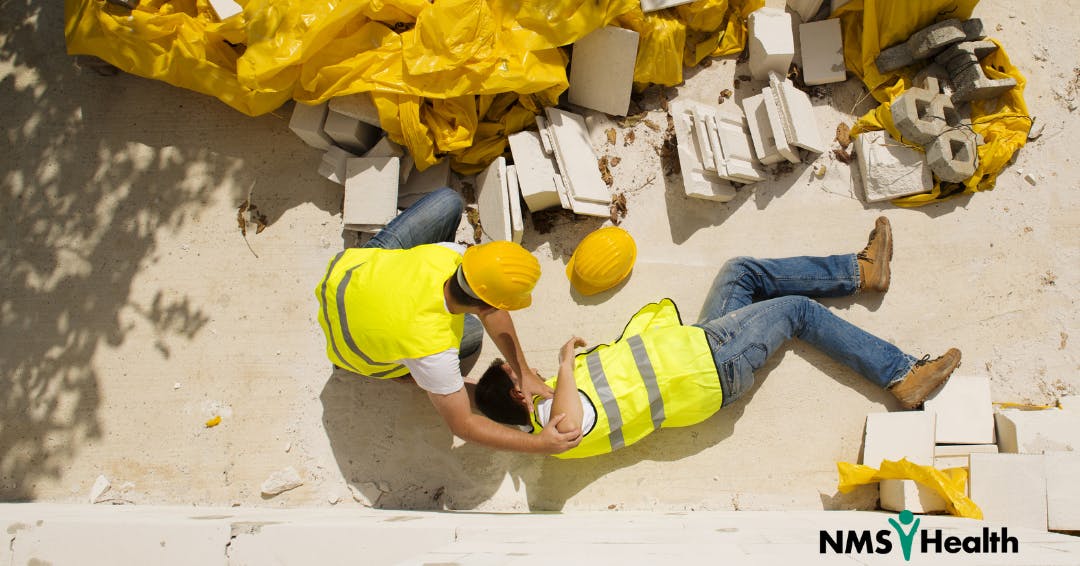June is National Safety Month; the annual observance that focuses on creating a safer environment from the workplace to anyplace sponsored by the National Safety Council. The final topic in this month-long series is on Slips, Trips, and Falls.
Slips, trips, and falls at work are incredibly common and can result in serious, and sometimes fatal injuries. According to the National Safety Council, in 2020 alone, more than 211,000 workers suffered injuries that required days off from work, and 805 workers passed away due to a fall accident. Workers don’t even have to fall from high levels to suffer injuries. 127,680 workers were injured, and 136 workers died after falls on the same level.
The outlook is even more grim for those who work in construction. For construction workers, slips, trips, and falls are the leading cause of workplace deaths. These workers are most at risk for falls from height, at seven times the rate of other industries, but they do have high rates of falls on the same level and slips and trips without falls. Additionally, in 2019, falls, slips, and trips accounted for 32 percent of nonfatal injuries involving days away from work in the private construction industry. These cases resulted in a median of 28 days away from work according to the Bureau of Labor Statistics.
What can employers do?
The bad news is that the issues that commonly lead to falls are generally complex and can involve many factors, like human error or equipment issues. The good news is that falls, slips, and trips are preventable! Employers are the first line of defense in protecting workers from dangerous situations that could cause falls, slips, and trips.
According to OSHA’s Walking-Working Surfaces guidelines employers are required to ensure:
- All places of employment, passageways, storerooms, service rooms, and walking-working surfaces are kept in a clean, orderly, and sanitary condition.
- The floor of each workroom is maintained in a clean and, to the extent feasible, in a dry condition. When wet processes are used, drainage must be maintained and, to the extent feasible, dry standing places, such as false floors, platforms, and mats must be provided.
- Walking-working surfaces are maintained free of hazards such as sharp or protruding objects, loose boards, corrosion, leaks, spills, snow, and ice.
- The employer must ensure that each walking-working surface can support the maximum intended load for that surface.
- The employer must provide, and ensure each employee uses, a safe means of access and egress to and from walking-working surfaces.
- Walking-working surfaces are inspected, regularly and as necessary, and maintained in a safe condition; hazardous conditions on walking-working surfaces are corrected or repaired before an employee uses the walking-working surface again. If the correction or repair cannot be made immediately, the hazard must be guarded to prevent employees from using the walking-working surface until the hazard is corrected or repaired; and when any correction or repair involves the structural integrity of the walking-working surface, a qualified person performs or supervises the correction or repair.
It is important for employers to work together with their workers to make action plans ahead of time, assess job sites for any risks, provide the right training and equipment and make sure it is used every time. Employers can conduct site-specific inspections to identify hazards, hold regular team meetings about safety procedures so workers can identify potential issues, and ensure that PPE is being used correctly.
The National Safety Council also suggests:
- Discuss the task with coworkers and determine what safety equipment is needed
- Make sure you are properly trained on how to use the equipment
- Scan the work area for potential hazards before starting the job
- Make sure you have level ground to set up the equipment
- If working outside, check the weather forecast; never work in inclement weather
- Use the correct tool for the job, and use it as intended
- Ensure stepladders have a locking device to hold the front and back open
- Always keep two hands and one foot, or two feet and one hand on the ladder
- Place the ladder on a solid surface and never lean it against an unstable surface
- A straight or extension ladder should be 1 foot away from the surface it rests on for every 4 feet of height and extend at least 3 feet over the top edge
- Securely fasten straight and extension ladders to an upper support
- Wear slip-resistant shoes and don't stand higher than the third rung from the top
- Don't lean or reach while on a ladder, and have someone support the bottom
- Never use old or damaged equipment; check thoroughly before use
Sources
Bureau of Labor Statistics, U.S. Department of Labor, The Economics Daily, Fatal and nonfatal falls, slips, and trips in the construction industry at https://www.bls.gov/opub/ted/2021/fatal-and-nonfatal-falls-slips-and-trips-in-the-construction-industry.htm (visited June 26, 2022).
https://www.nsc.org/workplace/safety-topics/slips-trips-and-falls/slips-trips-and-falls-home
https://www.osha.gov/laws-regs/regulations/standardnumber/1910/1910.22


